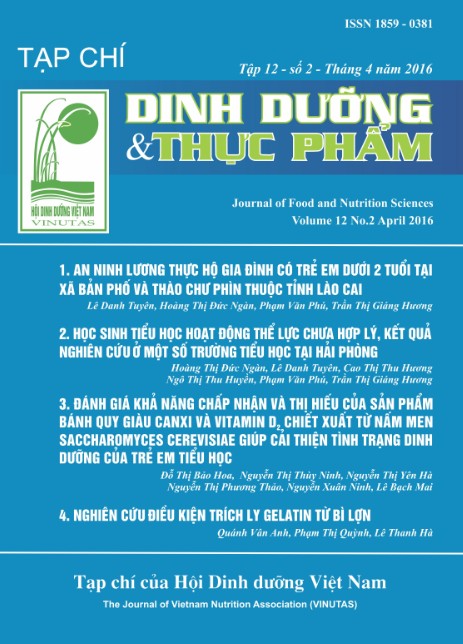EVALUATION OF ACCEPTABILITY AND PREFERENCE OF BISCUITS FORTIFIED WITH CALCIUM AND VITAMIN D 2 EXTRACTED FROM YEAST SACCHAROMYCES CEREVISIAE AMONG PRIMARY SCHOOL CHILDREN TO IMPROVE THEIR NUTRITION STATUS
Main Article Content
Abstract
The objective of this study was to research the acceptability and preference of fortified biscuits in primary school children. The study was a community intervention in 17 weeks (85 days). Children (n= 184) from two primary schools in Gia Binh district – Bac Ninh province were recruited. They were divided into 2 groups. Control group: had biscuits fortified with calcium. Intervention group: had biscuits fortified with calcium and vitamin D2. Each child had 25 g of biscuits per day. This research showed that all biscuits were well accepted. In general, the difference of acceptability and hedonic test between 2 groups was not significant. The average product amount consumed in both groups was 91.8%. Nobody had any signs of gastrointestinal disturbance during intervention time. On average, 72.3% of the children in both groups liked product. The results showed that micronutrient fortified biscuits might be a feasible solution to improve children nutrition status in the community.
Keywords
Vitamin D2, Saccharomyces cerevisiae, acceptability, preference
Article Details
References
2. Agellon S., El Hayek J., Hazell T. J., Finch S., Jean-Philippe S., Pham T. T., Rodd C., Rauch F., Vanstone C.A., Weiler H.A.(2013). Vitamin D status in Montréal preschoolers is satisfactory despite low vitamin D intake. J Nutr. 143(2)(2013). 154-60. doi: 10.3945/jn.112. 169144. Epub 2012 Dec 19.
3. Garemo M., Lenner R. A., Strandvik B. (2007). Swedish pre-school children eat too much junk food and sucrose. Acta Paediatr.96(2)(2007). 266-72.
4. Hettiarachchi M., Liyanage C. (2012). Coexisting micronutrient deficiencies among Sri Lankan pre-school children: a community-based study. Matern Child Nutr.;8(2)(2012):259-66. doi:10.1111/j.1740-8709.2010.00290.x.
5. Aggarwal R., Marwaha R. K., Reddy D. R., Singh R., Sawhney R. C., Singh S., Tandon N. (2005). Vitamin D and bone mineral density status of healthy schoolchildren in northern India. Am J Clin Nutr, 82(2)(2005) , 477-82.
6. Chlebna-Sokół D., Golec J., Karalus J., Michałus I., Rusińska A. (2011) The vitamin D and calcium consumption and bone quality in children of łódŹ (Poland) at the age 9-13 years. Pediatr Endocrinol Diabetes Metab. 17(2)(2011) . 82-7.
7. Choucair M. K., Deeb M. E., El-Hajj Fuleihan G.A., Kizirian A. S., Nabulsi M. M., Salamoun M. M., Tannous R. I. (2005) Low calcium and vitamin D intake in healthy children and adolescents and their correlates. Eur J Clin Nutr, 59(2)(2005) , 177-84.
8. Harry T.L., Hildegarde H. (2013) Sensory Evaluation of food. Spinger Science and Business Media, New York, pp.325 2013
9. Arnaud Laillou, Frank Wieringa, Thuy Nga Tran, Pham Thuy Van, Bach Mai Le, Sonia Fortin, Thi Hop Le, Regina Moench Pfanner, and Jacques Berger (2013). Hypovitaminosis D and Mild Hypocalcaemia Are Highly Prevalent among Young Vietnamese Children and Women and Related to Low Dietary Intake. PLoS One. 8(5):e63979.
10. Hà Duyên Tư (2006). Kĩ thuật phân tích cảm quan thực phẩm. Nhà xuất bản khoa học kĩ thuật, 2006.


